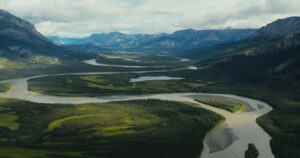In the Nunavik region of northern Quebec, not far from Ungava Bay, lies a perfectly round oddity known as the Pingualuit Crater. With a diameter of 3.44 kilometres, the crater stands out in any aerial view. When it’s not frozen, which is most of the year, it is filled with icy water. Some have called it the eighth wonder of the world.
The crater came to the world’s attention in 1950. Though the local Inuit knew of it for centuries, the western world only discovered it when U.S. Air Force flew over it in 1943. Pilots saw an almost perfect circle stamped into the surface of the earth. It was not on any maps. They made multiple passes to confirm that they weren’t hallucinating.

First known photo of Pingualuit Crater, taken by USAF pilots.
A secret WWII landmark
For the rest of World War II, pilots used the crater, which they kept secret, as a navigation aid. After the war ended, the photos were released and mesmerized the public. People concocted theories about how this lake, with no apparent water sources, had formed.
The most popular explanation was that it was a volcano. In 1950, the first expedition to Chubb Crater (as it was then known) took place, under Frederick Chubb and Victor Meen. Chubb believed that it was an old volcano and hoped to find diamonds at the site. Meen was convinced that it was a meteor crater. In the end, that first trip yielded neither diamonds nor meteorites.
Meen was still sure that he was correct. The following year, he made a second trip to the crater. This time, he did make a discovery: a magnetic anomaly on the rim of the crater. He thought that this was the sign of a meteorite.
Though his explanation for the magnetic anomaly was incorrect, scientists did eventually confirm that a meteor formed Pingualuit. This made it the first meteor crater found in Canada. Two dozen others have since been identified, but the Pingualuit Crater is the youngest.

The Pingualuit Crater via Google Earth.
The Crystal Eye
Researchers believe that the impact happened 1.4 million years ago. It would have been 8,500 times stronger than the atomic bomb that hit Hiroshima. As the meteor smashed into the surface of the earth, it forced the rock on the surface to move upwards and outwards. This formed a raised ring on the otherwise flat tundra that does somewhat resemble an old volcano.
At 267m deep, the lake is one of the deepest in Canada. Because other rivers or streams cannot add any pollution, it has the second-highest water clarity of any lake on the planet; the first is Lake Mashu in Japan. Its appearance may be why the Inuit have always referred to it as the Crystal Eye. For them, it is a sacred place of healing.

Pingualuit Crater. Photo: mybestplace.com
Though we now understand the formation of the crater, it still holds a mystery. Rain and snow filled the lake over the eons. No tributary leads in or out of the site. Yet somehow, it holds a thriving population of arctic char.
These cold-water fish live in arctic coastal areas and lakes, but no one knows how they got into this body of water. The fish live in such extreme conditions that they must rely on cannibalism to survive. They look very different from other populations of their species.
Today the crater is protected within a Quebec reserve known as Pingualuit National Park.






